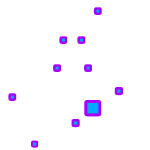OMECHANGA
A Chess Variant By Simon Edward JeppsDownload ~ PDF ↷ ⋱ ⋱ Chatblog ⨗
Introduction
 Omechanga is a 'double variant', both of modern Chess and ancient Chaturanga. As such it is an 8x8 square variant employing Western pieces and two 8-sided dice within an Indian-inspired arena.
Omechanga is a 'double variant', both of modern Chess and ancient Chaturanga. As such it is an 8x8 square variant employing Western pieces and two 8-sided dice within an Indian-inspired arena.
'Chaturanga', which literally translates as "four armies" is the origin of Chess, an 8x8 square, four-player board game played with dice. Whilst the origins of Chess will always be contested, this translation and iteration has been commonly accepted amongst likeminded Chessicians.
There is another interpretation, which claims the name means "four divisions" of an army and these claimants uphold it to be a two-player game much like Western Chess. However, firstly the specifier of 'divisions' is abscent from the translation and secondly the King's [Raja] administration (which includes a General [Senāpati]) would serve as a fifth division, if His own were reasonably included in this interpretation. I mean, while these two may well just "push pencils" in modern real life, in the game at least they are an active "arm" of the military.
In any case, the two-player interpretation just seems to be a manipulation of language to fit something it realistically doesn't, and so for the purpose of this article the four-player game with dice is the iteration Jeppsquare recognises as the true origin of Chess.
Omechanga gets its name from combining 'Omega' with 'Chaturanga' ~ for herewith, for the first time in history, the most ancient game on earth is being resurrected with the special introduction of the famous Omega Wizard into its new form.
Readers of my website will know I have undertaken a similar task oftentimes ~ to transpose Chaturanga into Western Chess ~ and will be familiar by now with how monumental a task it actually is. Without boring you to death with all the details, whence undertaking such a task you inevitably find yourself in a vicious circle of needing to invent more rules to remedy incompatibilities, whilst at the same time trying to re-simplify the rules to be as closely digestible as Classical Chess.
Herewith, whilst there are indeed some such "extra" rules in Omechanga, I have thus had plenty of experience over many years at tackling this paradox ~ enough in fact {"phew" wipes brow} to say these extra conditions are now so expertly diluted I can quite confidently declare this game to be the best, if indeed the final evolution of Jeppsstyle Chaturanga.
Note: All images are zoomable in page & open larger in new tab / or if downloaded.




About The Game
Omechanga is identical to Chaturanga except that it features only two players, a Western piece array and one additional piece each known well as the Omega Wizard.Furthermore this game uses two 8-sided dice, in contrast to the original 'four-sided stick-dice' once used in ancient India. These dice, known as "D8"s in the retail world, are widely available everywhere.
There are also Special Moves for all Pieces, Pawns & Wizard, obtained via the dice. For this reason Omechanga Wizards are portrayed differently to the standard Omega Wizard icon of a crescent moon, to instead encompass its person as a figurine.
The Omechanga board is setup at the beginning of the game as shown in Diagram 1. The setup is practically identical to Chaturanga except the Rook and Bishop placements are reversed. The Bishop would be a Boat in Chaturanga, the Rook an Elephant and there would be four armies with four Kings rather than both a King & Queen each between two players. The Omega Wizard, of course adopted from Omega Chess, yet featuring its Omechanga 'Special Knight Move', is likewise unique to this game.
In keeping with Chaturanga ("four armies") tradition, each block of pieces is setup in the order of 'King to the player's left hand'. For this reason both Queens sit on dark squares whence transposed to the Western.
The board setup might look strange at first, especially regarding the Queen's proximity to the King, but as you learn the dynamics of the game you will see and understand its eternal charm.
In fact, the key component that makes this particular transposition work, is indeed the Queen. For in Omechanga, the Queen MAY NOT capture INTO or BE captured FROM the opponent's side of the board UNTIL She has made Her FIRST MOVE. A solidly secure design trait both offensively and defensively. Furthermore, Her range is diminished to TWO squares in ANY direction, UNLESS a Double 6 is rolled, which extends Her range to SIX squares.
The remaining design traits are purely the evolved artistry of experience with the dynamics and character of this ancient and most splendid game. Enjoy.



How To Play
As mentioned Omechanga uses two 8-sided dice, thrown by the player on each turn. The dice offer a choice of two pieces to move, or a number of points if you choose not to move or cannot move.Whoever wins the game by capturing their opponent's King, is awarded 8 points plus any points won during play. The player with most points after 5 games wins the tournament.
- There is NO 'Check' or 'Check-Mate' ~ you MUST capture the King!
 Before we get into the specifics of game-play, let us first learn the moves of the pieces. Indeed they are the same pieces adopted from Western Chess yet their abilities have been adjusted to fit more compatibly with the way Chaturanga-style pieces are positioned and engaged during play.
Before we get into the specifics of game-play, let us first learn the moves of the pieces. Indeed they are the same pieces adopted from Western Chess yet their abilities have been adjusted to fit more compatibly with the way Chaturanga-style pieces are positioned and engaged during play.
One of the things you will thus notice, is how their range has been diminished. This is firstly due to their orientation of setup in this arena, reducing unfair irrational attacks, but secondly to likewise reduce their impact whence granted powerful opportunities by the mere rolling of the dice.
Yet worry not, for their Western traits are actually preserved in Special Moves.
The Pieces
♙Pawns can move TWO squares orthogonally forward OR sideways at ANY time but ONLY whence about their OWN side of the board. Pawns may ONLY move ONE square forwards or sideways after crossing the center line.
- Thus, a 2-square move arriving PAST the center line is NOT allowed.
- Like a KNIGHT sans capture if a Double 1 is rolled.
- Pawns still ONLY capture ONE square diagonally forward.
Knights leap/capture in a 2x1 'L' pattern, as they do in Classical Chess, yet may leap TWICE if a Double 2 is rolled.
- Yet only capturing ONCE & so to HALT when captures.
Bishops move/capture THREE squares diagonally, SIX if a Double 3 is rolled.
♖
Rooks move/capture FOUR squares orthogonally, EIGHT if a Double 4 is rolled.
♔
The King moves/captures ONE square in ANY direction, as it does in Classical Chess, or in a 3x1 'L' pattern if a Double 5 is rolled.
♕
The Queen moves/captures TWO squares in ANY direction, SIX if a Double 6 is rolled.
- The Queen MAY NOT capture INTO or BE captured FROM the opponent's side of the board UNTIL She has made Her FIRST MOVE!
- The Queen's Pawn MUST move SIDEWAYS or capture on its FIRST MOVE.
THE WIZARD
☽
 At the beginning of the game the Wizard sits off-board and enters to any vacant square on the home rank (1/8) or the home-side Queen-file (a/h).
At the beginning of the game the Wizard sits off-board and enters to any vacant square on the home rank (1/8) or the home-side Queen-file (a/h).
In the diagrams, I have drawn the Wizard to be sitting off-board just in between the d/e files ~ yet this is not a rule. I personally prefer them positioned at opposite corners to each other, as shown in the photos.
- The Omega Wizard moves and captures like a long Knight, leaping in a (3x1) 'L' pattern, or alternatively it may slide ONE square diagonally.
- If a Double 7 is rolled, the Wizard can move/capture like a Knight in addition to its regular move during the turn. Yet only capturing ONCE & so to HALT when captures.
As for real-life physical pieces, it isn't so important how the figurine looks as long as it is obviously different to the other pieces. I personally use a Jester from a beautiful burnt-wood Jester Chess set I bought many years ago. And I think it looks the part. After all, if a Wizard always wore moons & stars everyone would know! I think a wise wizard would probably keep all that nonsense a secret.
Diagram 2 explains dice values, piece powers & notably setup.



The Dice & Their Powers
The two Omechanga 8-sided dice, thrown by the player on each turn, offer a choice of two pieces to move, or a number of points if you choose not to move or cannot move.Whoever wins the game by capturing their opponent's King, is awarded 8 points plus any points won during play. The loser does NOT retain any points.
 There is a pinnacle Omechanga strategy here, in that by sacrificing your move to receive points instead, you can increase your overall position or lead in an ongoing tournament.
There is a pinnacle Omechanga strategy here, in that by sacrificing your move to receive points instead, you can increase your overall position or lead in an ongoing tournament.
Herewith, the player with most points after 5 games wins the tournament.
- The two 8-sided dice are rolled each turn - their values representing a CHOICE of TWO pieces to move, or ANY if an '8'.
- Only ONE piece may be moved in any turn, except of course when Castling.
The values/powers of the dice are as follows.
- 1 = Pawn / If a Double: Pawn may move SANS capture like a KNIGHT.
- Very useful if Castling Queen-side.
- 2 = Knight / If a Double: Knight may move TWICE.
- Yet only capturing ONCE & so to halt when captures.
- 3 = Bishop / If a Double: Bishop may move/capture SIX squares.
- 4 = Rook / If a Double: Rook may move/capture EIGHT squares.
- 5 = King / If a Double: King may move/capture like a CAMEL.
- The Camel moves like a LONG Knight, in a 3x1 'L' pattern.
- 6 = Queen / If a Double: Queen may move/capture SIX squares.
- 7 = Wizard / If a Double: Wizard may move like a KNIGHT in addition to its regular move.
- Yet only capturing ONCE & so to halt when captures.
- 8 = ANY Piece SANS capture / If a Double: Any Piece WITH capture.
Remember: If a Player cannot move or does not want to move, the total value of the dice are awarded as points for the turn.
Diagram 3 explains Castling, Notation, Promotion & Victory.



Castling & Notation
 Castling is similar to Classical Chess except the King moves THREE squares Queen-side and the Player also has to clear a Pawn out of the way. However notation remains the same.
Castling is similar to Classical Chess except the King moves THREE squares Queen-side and the Player also has to clear a Pawn out of the way. However notation remains the same.
Player requires BOTH a 4/Rook & 5/King to Castle. However MAY also use an 8/Any combo with Rook/King or even a Double 8/Any.
Castling King-side is more common because it is much easier and safer in the short term. The opponent's Queen looks very dangerous but remember it cannot do any harm until it has began to move and besides, whence chance/luck is in control you wouldn't want to take any risks with such a valuable piece.
Castling Queen-side, whilst indeed more ambiguous, is much safer in the long term because likewise your own Queen is self-defended until it begins to move and, the King whence positioned here is furthest from central threats. Also both your Rooks are now a connected team. Entering your Wizard here will also reinforce the Castling, as demonstrated above.
NOTATION
Classical, except Pawns are always logged square-to-square.
Promotion & Victory
Upon reaching the opponent's home rank (1/8), a Pawn MAY promote ONLY onto a square of its OWN colour and ONLY to a piece previously captured. There are NO "double Queens".VICTORY
Unless a Double is rolled first time...
... Should the Player roll the required value/piece in order to Capture the King, the player MUST roll the required value/piece AGAIN to actually execute the capture and claim Victory.
Attempting Victory is the ONLY time a player may roll the dice a maximum of THREE times, or thus two re-rolls of BOTH dice. However ONLY if the required value/piece wasn't rolled until the SECOND attempt ~ otherwise the dice may ONLY be rolled TWICE, as per usual.
If a Double is rolled first time, the Player may just go ahead & Capture the King!



Summary
Many years ago I bought a devotedly designed version of the original ancient Chaturanga ~ with Elephants, Boats & 'face-adorned' Foot soldiers & Kings. It became quite naturally one of my most prized posessions.
And this is where I discovered something quite amazing.
I am a very spiritual person and I have actually spent my entire life writing a philosophical masterpiece ~ it all started as a schoolboy with my first exercise-book-converted scripture, "The Possibility Of God." To get to the point, the current evolution of my book is very different to that of schooldays, it is incredibly grande, exquisitely ornate and growing with each and every year. I do not intend to publish it whilst I am alive however because my religion and the practise of writing my book are two and one the same continuum. I will leave it in my will for a designated party to publish on my behalf.
So, digressive ramblings aside... what did I discover?
I discovered that playing 'Chess' with 'God' is actually fantastically enjoyable. Yes, with God.
You see, you can't do this with regular Chess because firstly there are no dice and secondly modern Chess is a full-frontal hyper-intellectual wargame, whereas the original ancient Chaturanga harbours a deeper, more enriching philosophy.
That philosophy, believe it or not, is peace not war.
Unto God...
Chaturanga, the origin of Chess, is indeed a most sacred game handed down through ancient Indian texts dating back thousands of years.Unfortunately Chess today has been engineered into an ultimate face off between two mad Kings who's common identity of the Cross founds their disagreement and unto which they declare a woman must fight in war to defend their selfish idiocracies.
This was not in any way the original practice or purpose of Chaturanga.
Quietly in fact much the opposite, since it was to be that Chaturanga would heal the meanderings of conflict, into a craft of understanding amongst enemies.
 For the four armies take their places around the four sides of the sixty four square board. The number eight signifying eternity and the four armies the sacred squaring of a circle.
For the four armies take their places around the four sides of the sixty four square board. The number eight signifying eternity and the four armies the sacred squaring of a circle.
Behold this now an eternal game of an eternal world.
Historically thus, the game of "four armies" would be played with dice, whereby their outcome would decide which pieces a player would be allowed to move.
The reason for this is a deeply philosophical one.
God understands there may indeed be a time of war whence those whom block up their ears refuse to embrace good and righteous reasoning.
Yet it should not be in any man's eyes to seek pleasure from wrong doing and the pains of innocent people.
For this reason Chaturanga is the conversational ground between God and war. Whence the dice are cast it is only chance that decides what pieces shall be moved and under no circumstances shall any man alone pick up his sword and make for himself an unrighteous kingdom.
This is in itself a teaching that, whilst it is right to overthrow and destroy an evil ruler, war is only ever to be regarded as the unfortunate work of chaos and not the divine instruction of God.
Thus, through the medium of a friendly pastime, Chaturanga brings people together in a way that not only entertains and asserts their intellect, but which leaves them feeling spiritually nourished... even whence they had lost the game.
Finally it leaves open the possibility of hope, that amidst all pain and suffering, amidst all monumentally uncertain odds, just maybe... all is not lost.
So in light of this... let us now welcome the good Wizard of Omechanga into our humble abode.



Omechanga Solitaire
Whilst it is not unusual for Western Chess players to partake in 'solitaire' games by themselves, these are in all rationality, only for Opening and positional studies. For in Western Chess your only opponent is either a real living person or an artificial intelligence simulation.Omechanga Solitaire is on the other hand a much more sentimentally intimate encapsulation of a "virtual" companion.
That is to say, Omechanga Solitaire embraces through the dice, the abstract concept of a supernatural opponent. You could call this opponent 'Karma', 'Chaos' or even 'God'. Yet for the passionate dedication and purpose for which this game was designed, we will call our companion 'God'.
Thus the spiritual practise of Omechanga Solitaire is the assertion, proclamation and ascension unto complete honesty and adherence unto God.
 This is a game then, of intellectual honesty and an exercise of solitary morale.
This is a game then, of intellectual honesty and an exercise of solitary morale.
Omechanga Solitaire here then provides the virtual grace of a 'paranormal intelligence' so to speak, in that the dice determine the piece choices of your opponent.
Whilst it cannot be guaranteed any divine intervention may ever take place, for that is a wonder only knowable by the participant, it is certainly a cosmological truth that God art at least one and of all things.
Thus here, whilst there is no living breathing opponent to challenge you, there is certainly a living breathing law of cosmos to challenge you.
In this respect, it is God who determines the granted values of the dice.
This is one half of the conversation.
The second half of the conversation is your assertion unto complete honesty with God.
The pieces have been provided for, you have been given the grace of which if any pieces your opponent may move in his turn.
It is now your choice to decide, given the pieces shown on the dice and in all complete honesty, what would be the best move your opponent should make?
Aye, perhaps it is your own turn and yet the dice do not grant you the pieces you desire. Is this fair? Well, it is no fairer than a usual game of Omechanga with a usual opponent.
So, when your opponent likewise is only given the choice of a Pawn... and out of all the Pawns on the board... there is one which can trap your most valued piece... do you grant him this success?
A game played with utmost honesty is truly a wondrous spectacle of thine faith. For even as it is yourself who moves the pieces, it is the spirit of God's laughter that moves the dice.
Thus... which do you value more, your triumph over truth, or your mutual ascension unto God?



Of Souls & Time
I have been playing Omechanga Solitaire, albeit previous incarnations of this game before now, for many, many years.A conversation and communion with God, it certainly is.
That is to say whilst I personally have experienced impossibly unlikely odds of certain positions and piece abilities thereof, the true communion and conversation I am able to describe, is that of one's inner, most soul-felt meanderings about life amidst the actual positions on the board.
 In other words Omechanga Solitaire is akin to walking through a deep forest, with birds, lakes, deer, frogs, flowers, insects, rivers and many, many paths... all such paths taking one through a different perspective on life, on its meaning unto yours... and ultimately unto God.
In other words Omechanga Solitaire is akin to walking through a deep forest, with birds, lakes, deer, frogs, flowers, insects, rivers and many, many paths... all such paths taking one through a different perspective on life, on its meaning unto yours... and ultimately unto God.
Sometimes in life we can feel very lonely, even whence we have friends and even, whence we have God.
Yet if thou truly believes there should be a God, thence it is now you must create for yourself a more intimate relationship with all that you feel brings you ever closer unto your God's presence.
Sometimes whilst God's love can only help us from within ourselves, it is not wrong to desire a moment of hope for a physically-spiritual companionship "of kind."
And so, for now at least until the day all my works are completed, in peace I give you... Omechanga Solitaire.
Oh and, don't just listen to the birds outside your window, sing back to them as well. Feed them and water them... bring their world into yours and yours unto theirs.
And in the night, remember the Stars and their magical light, remember they don't just twinkle because they can... they twinkle because they desire to be noticed, the Heavens are shining for allkind. Even a Nightingale knows this. So ignore the naysayers, they only say nay because they don't know any birds.
Thank you for reading.
Chatblog ⨗
 |  |





